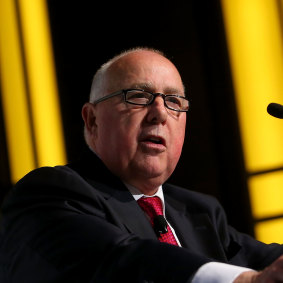
Loading
So how much we should worry about inflation expectations is an empirical question: is the idea borne out by the facts and figures?
In 2022, Dr John Bluedorn and colleagues at the International Monetary Fund conducted a study of the historical evidence for wage-price spirals in the developed economies, concluding that a jump in wage growth shouldn’t necessarily be seen as a sign that a wage-price spiral is taking hold.
Bluedorn elaborated on these finding at the Reserve Bank’s annual research conference last September. The discussant for his paper was Iain Ross, former president of the Fair Work Commission and now a member of the Reserve’s board.
Ross (and leading labour market economists, such as Melbourne University’s Professor Jeff Borland) readily agree that Australia experienced a wage-price spiral in the 1970s. But both men conclude that our circumstances 50 years later are “very different”, which means it should be possible to sustain steady wage growth without initiating a wage-price spiral.
In mid-2022, Borland listed three respects in which our present circumstances are different. First, upward pressure on wages is being limited on the supply side by employers’ ability to give extra hours of work to part-time workers who’d prefer more hours, and by drawing more participants into the jobs market.
Second, changes in the “institutional environment” since the 1970s have reduced the scope for people to get wage rises based on the principle of “comparative wage justice” – “Those workers have had a pay rise, so it’s only fair that we get the same.”

Reserve Bank board member Iain Ross has said a wage-price spiral would be unlikely in current circumstances.Credit: Pat Scala
And third, a decline in the proportion of workers who are members of a union, and a range of other factors, have reduced workers’ bargaining power, thus limiting the size of wage increases likely to be obtained.
There could hardly be anyone in the country better qualified than Ross to explain how the institutional arrangements governing the way wages are set have changed over the decades. He told the conference that “these changes have been profound and substantially reduce the likelihood of a wage-price spiral”.
The central difference was that, in the 1970s and 1980s, the institutional arrangements facilitated the transmission of wage increases bargained at the enterprise level – usually by unions in the metal trades – to the relevant industry sector and then ultimately to the broader workforce.
There were four important respects in which the present rules are very different. First, the new “modern awards” operate as a minimum safety net and the circumstances in which minimum wages may be adjusted are limited. In effect, there is no scope to adjust minimum award rates to reflect the outcome of collective bargaining at the enterprise level.
Second, the Fair Work Act limits the general adjustment of all modern-award minimum wage rates to one annual wage review conducted by the Fair Work Commission.
Third, enterprise agreements need to be approved by the commission before they acquire legal force. The length of agreements averages three years, during which time employees covered by that agreement can’t lawfully engage in industrial action in pursuit of further wage rises.
Fourth, the sanctions against engaging in such industrial action are, Ross said, “readily accessible and effective”.
Ross noted that the proportion of all workers who are members of a union has fallen dramatically since the 1970s. From a little above 50 per cent, it has fallen to 12.5 per cent. And in the private sector it’s down to 8.2 per cent.
Loading
The manufacturing sector and its unions were central to the wage-price spiral of the 1970s. But manufacturing’s share of total employment has fallen from 22 per cent to 6 per cent, while the proportion of union members in manufacturing has fallen from 57 per cent to 10 per cent.
Whereas the annual number of working days lost to industrial disputes was about 800 per 1000 employees during the 1970s, these days it’s next to nothing.
Ross said the present enterprise bargaining arrangements operate as a shock absorber by constraining the bargaining capacity of employees subject to an agreement. “To date there is no evidence of the emergence of a wage-price spiral in the present circumstances and recent data suggests such an outcome is unlikely,” he concluded.
My point is, there’s no reason for the Reserve to live in fear of an imminent worsening in inflation expectations if workers and their unions’ ability to turn their expectations into higher wages is greatly constrained. That being so, we shouldn’t allow impatience to get the inflation rate back to target to worsen the risk we’ll end up in a recession, the depth and length of which could greatly impair our return to full employment.
Ross Gittins unpacks the economy in an exclusive subscriber-only newsletter. Sign up to receive it every Tuesday evening.









 Add Category
Add Category